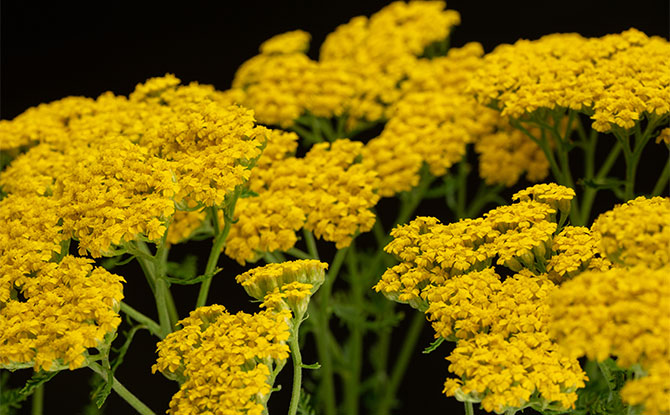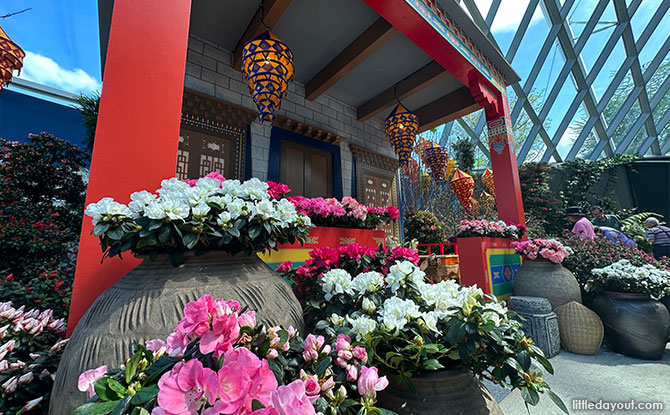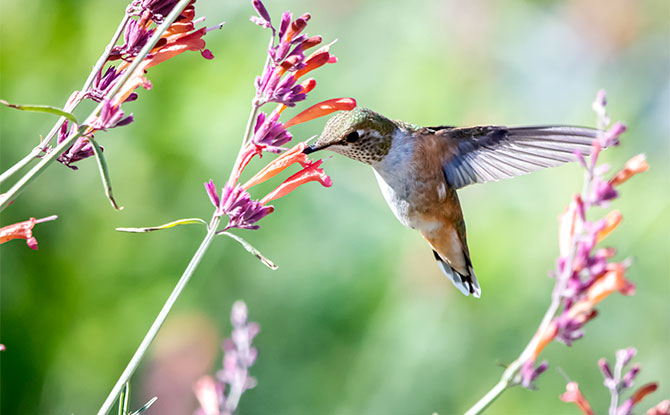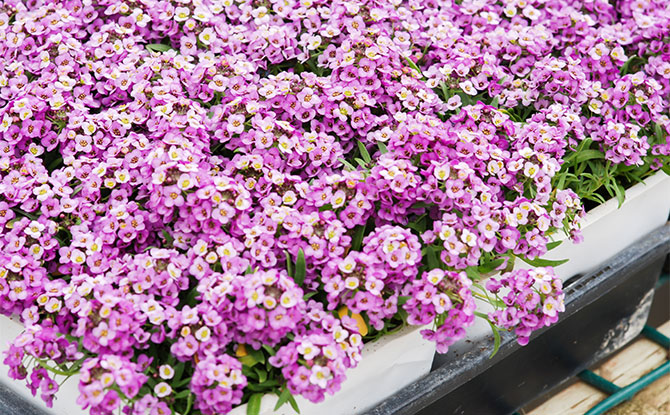
Welcome to our comprehensive guide to flowers that start with the letter A. Whether you’re a gardening enthusiast or simply looking to expand your knowledge of floral beauty, this article is packed with fascinating information about the diverse array of A flowers. From stunning blooms to symbolic meanings, we’ll explore everything you need to know about these exquisite plants.
Flowers beginning with A captivate with their vibrant colors, delicate petals, and unique characteristics. They can brighten up any garden, add charm to floral arrangements, and evoke a sense of wonder and joy. In this article, we’ll take you on a journey through a world of wonderful flowers that start with A.
From the captivating Acacia with its beautiful symbolism to the elegant Amaryllis and its striking blooms, we’ll explore the wide variety of flowers that start with letter A and even touch on their symbolism. Whether you’re a beginner or an experienced gardener, there’s something for everyone in this guide.
So, join us as we venture into the world of flowers that start with A. Discover the wonders of Acacia, the allure of Angel Trumpet, the elegance of Anemone, and so much more. By the end of this article, you’ll have a deeper appreciation for these stunning blooms and perhaps even some inspiration for your own garden or floral arrangements.
DINO-TASTIC EXHIBITION: Meet a 40m Long Dino Face-to-Face
GIVEAWAY FOR ENEWSLETTER SUBSCRIBERS: LEGO NINJAGO SET
Wonderful Flowers that Start with A
When it comes to flowers that start with A, there is an abundance of stunning options to choose from. These beautiful flowers not only add color and vibrancy to any garden or floral arrangement, but they also possess unique characteristics that make them truly wonderful.
From their vibrant colors to their delicate petals, each flower beginning with A has its own charm and allure.
Acacia
Acacia is a genus of flowering plants that belong to the family Fabaceae. With over 1,000 different species, Acacia flowers captivate with their beauty and delicate charm. These flowers come in a variety of colors, including vibrant yellows, whites, pinks, and oranges, making them a delightful addition to any garden.
The Acacia plant is known for its resilience and adaptability, being able to thrive in various climates and soil conditions. It is a low-maintenance plant that requires minimal care once established. Acacia symbolism varies across cultures and regions, often representing purity, resilience, and friendship.
Acanthus
Acanthus is a genus of flowering plants that is well-known for its distinctive spiky leaves and beautiful flowers. These plants are highly admired for their unique architectural appeal and have been used extensively in various art styles and designs throughout history.
The Acanthus flowers are particularly striking, with their intricate patterns and vibrant colors. They add a touch of elegance and sophistication to any garden or floral arrangement. With their long, showy bracts and delicate petals, Acanthus flowers are a favorite among gardeners and floral enthusiasts.
One of the most significant features of Acanthus plants is their symbolic meaning. In Greek and Roman mythology, the Acanthus leaves symbolize enduring beauty and immortality. They have been historically used in the design of Corinthian columns and have become an iconic symbol in architecture and decorative arts.
Achillea
Achillea, commonly known as yarrow, is a genus of flowering plants that are prized for their delicate, feathery flowers. These beautiful plants belong to the Asteraceae family, which also includes sunflowers and daisies.
There are several species and varieties of Achillea flowers, each with its own unique characteristics and colors. Some popular varieties include Achillea millefolium (common yarrow) with its white or pale pink flowers, Achillea filipendulina (fern-leaf yarrow) with its golden-yellow flowers, and Achillea ptarmica (sneezewort) with its clusters of small, white flowers.
Achillea flowers have numerous uses. In landscaping, they are valued for their ability to attract pollinators such as bees and butterflies, making them an excellent choice for wildlife gardens. Their feathery foliage also adds texture and interest to flower beds and borders.
In herbal medicine, Achillea has long been used for its medicinal properties. The flowers and leaves of certain Achillea species are known for their anti-inflammatory and antiseptic properties, and they can be used to make herbal teas, tinctures, and poultices to treat various ailments.
Aconite
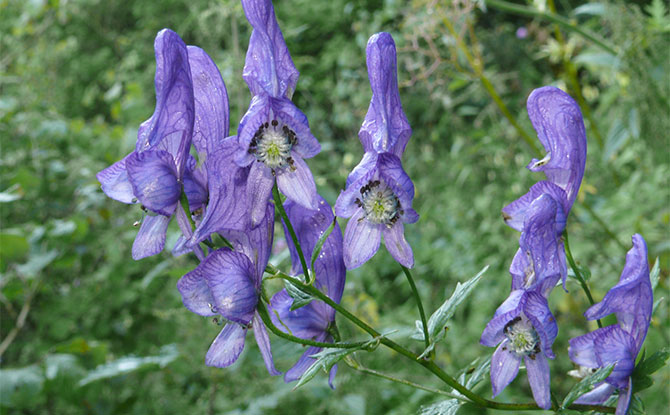
Aconite, also known as monkshood, is a genus of flowering plants that are renowned for their striking blue, purple, or white flowers. These beautiful Aconite flowers are a stunning addition to any garden or floral arrangement. However, it is important to be aware of that the Aconite plant is toxic.
While the vibrant colors and unique shape of Aconite flowers make them highly desirable, it is essential to handle them with caution due to their toxicity. Aconite plants contain a powerful poison called aconitine, which can be dangerous if ingested or even if their sap comes into contact with the skin.
Despite their toxicity, Aconite flowers have been used in traditional medicine for centuries, albeit in highly diluted forms. However, it’s crucial to consult with a qualified herbalist or healthcare professional before using Aconite for any medicinal purposes.
Adder’s Tongue
Adder’s Tongue is a genus of small perennial plants that are characterized by their distinctive tongue-shaped leaves and delicate yellow flowers. These beautiful flowers are a delightful addition to any garden or natural habitat.
The Adder’s Tongue flowers, also known as Erythronium, bloom in the spring and can be found in a variety of colors, including shades of yellow, white, and pink. Their unique shape and vibrant color make them a standout feature in any landscape.
In terms of habitat, the Adder’s Tongue plant is often found in forests, meadows, and other natural areas with moist, well-drained soil. Their unique shape and vibrant color make them a standout feature, while their delicate foliage adds a touch of elegance. By providing the right habitat and growing conditions, these plants can thrive and bring beauty to any outdoor space.
African Flame Lily
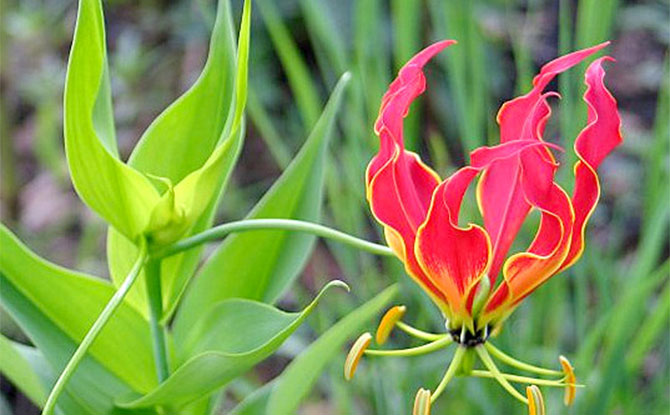
The African Flame Lily, also known as Gloriosa Lily, is a captivating climbing vine that boasts vibrant red and yellow flowers. With its striking colors and unique form, it is a favorite among gardeners and flower enthusiasts.
African Flame Lily flowers are characterized by their fiery red petals that gradually transition to a bright yellow at the center. Each flower consists of six distinct petals that curve backward, giving the flower a graceful and delicate appearance. These stunning flowers are perfect for adding a touch of tropical elegance to any garden or floral arrangement.
Symbolically, the African Flame Lily represents various meanings, including passion, beauty, and transformation. The flower’s vibrant colors and graceful form make it a powerful symbol of love and desire. Its ability to climb and reach great heights also symbolizes personal growth and resilience.
African Daisy
African Daisy, scientifically known as Osteospermum, is a genus of flowering plants native to South Africa. These charming flowers are a popular choice for gardeners and landscape enthusiasts, thanks to their vibrant colors and easy care requirements.
There are various species and varieties of African Daisy flowers, each with its own unique characteristics. Some popular varieties include the Osteospermum Ecklonis, commonly known as the African Daisy, which showcases striking daisy-like blooms in shades of purple, pink, and white.
Agapanthus
Agapanthus, commonly known as Lily of the Nile, is a genus of flowering plants that captivate with their large clusters of showy blue or white flowers. These elegant blooms make Agapanthus a popular choice for gardens and floral arrangements.
There are several species and varieties of Agapanthus, each offering its own unique charm. The ‘Headbourne Hybrids’ variety, for example, produces striking blue flowers that create a stunning visual impact in any garden. On the other hand, the ‘Albus’ variety showcases beautiful white flowers, adding a touch of elegance and purity to the landscape.
Almond Blossom
The Almond Blossom is the delicate and enchanting flower of the almond tree. It holds great cultural and symbolic significance in many regions, captivating people with its stunning beauty and fragrance. The Almond Blossom is a symbol of new beginnings, hope, and the arrival of spring.
Almond Blossom festivals and celebrations are held in various parts of the world to commemorate the blooming of these splendid flowers. These festivals often feature vibrant displays of Almond Blossom flowers, showcasing their ethereal beauty.
One such renowned festival is the Almond Blossom Festival in Agrigento, Sicily. This annual event celebrates the blooming of almond trees and attracts visitors from near and far. The festival includes parades, live music, traditional dances, and a variety of cultural events, all centered around the Almond Blossom and its significance.
Another famous festival is the Almond Blossom Festival in Capay Valley, California. This festival pays homage to the stunning Almond Blossom fields that blanket the valley in a sea of white and pink blooms. The event features food stalls, live entertainment, arts and crafts, and guided tours of the blossoming almond orchards.
The Almond Blossom flowers themselves are truly exquisite. Their delicate white or pink petals emerge in clusters, creating a breathtaking sight. These flowers not only add beauty to the landscape but also attract pollinators such as bees with their sweet fragrance.
Ambrosia
Ambrosia is a genus of flowering plants that includes various species of ragweed. These plants are known for their unique characteristics, the beauty of Ambrosia flowers, the details of the Ambrosia plant, and the allergy concerns associated with it.
Ambrosia flowers are small and greenish, often clustered in spikes. They are not typically cultivated for their beauty, but rather, for their role in the reproduction of the plant. The Ambrosia plant itself has a robust nature, growing well in various environments and producing abundant pollen.
However, Ambrosia plants can cause significant issues for those who suffer from Ambrosia allergy, also known as Ragweed allergy. Ragweed is a common allergen that affects many individuals, especially during the late summer and fall seasons when Ambrosia plants release large amounts of pollen into the air. The pollen can trigger allergic reactions in people, including sneezing, runny nose, congestion, itchy eyes, and even asthma symptoms.
Anemone
Anemone flowers are known for their stunning and diverse blooms that add a touch of elegance and beauty to any garden or floral arrangement. With their vibrant colors and delicate petals, Anemone flowers are a popular choice among gardeners and flower enthusiasts.
One of the fascinating aspects of Anemone flowers is their symbolism. These flowers are often associated with anticipation, excitement, and protection against evil. They are also known to symbolize fragile and fleeting beauty. Whether gifted or displayed, Anemone flowers make a meaningful statement.
There are several types of Anemone flowers, each with its own unique characteristics. From the vibrant and showy Anemone coronaria to the delicate and graceful Anemone blanda, there is an Anemone variety to suit every taste and preference.
Amaryllis
Amaryllis flowers are known for their stunning beauty and large, showy blooms. With their vibrant colors and elegant form, they bring a touch of glamour and sophistication to any garden or home. In this section, we will explore the care requirements for Amaryllis, discuss its symbolism, and provide tips on how to cultivate these magnificent flowers.
Amaryllis is often associated with beauty, love, and determination. The striking blooms symbolize radiant beauty and are often given as gifts to express admiration and affection. In Greek mythology, the flower is said to have emerged from the blood of a lovestruck nymph, carrying connotations of passion and desire.
Angel Trumpet
Angel Trumpet, also known as Brugmansia, is a genus of flowering plants that captivate with their large, bell-shaped flowers and enchanting fragrance. These exquisite flowers are truly a sight to behold, adding a touch of elegance and beauty to any garden or landscape.
Angel Trumpet flowers are known for their stunning size and shape. With their trumpet-like petals that open wide and curve gracefully, these flowers create a dramatic and eye-catching display. Their colors range from white and yellow to pink and peach, adding a vibrant touch to any outdoor space.
Anthericum
Anthericum is a genus of flowering plants that boasts attractive, star-shaped flowers. These delicate blooms come in a variety of species and varieties, each with its own unique charm and characteristics.
One of the standout features of Anthericum flowers is their star-like shape, which adds a touch of whimsy and elegance to any garden or floral arrangement. With their graceful petals and vibrant colors, Anthericum flowers are a delightful addition to any landscape.
Alyssum

Alyssum is a genus of small flowering plants that add a touch of delicate beauty to any garden or landscape. These charming plants are known for their fragrant blooms and come in a variety of species and varieties.
One of the most popular varieties of Alyssum is the sweet Alyssum (Lobularia maritima) with its clusters of petite, white or lavender flowers. This variety is especially attractive to pollinators like bees and butterflies, making it a great addition to any pollinator garden.
Another well-known variety of Alyssum is the perennial Alyssum saxatile, also known as Basket-of-Gold. This variety features bright yellow flowers that form dense carpets of color, perfect for filling in gaps in rock gardens or borders. It is also drought-tolerant, making it ideal for areas with limited water.
Alyssum flowers have several uses in landscaping and gardening. Their low-growing habit and profusion of blooms make them excellent ground covers or bedding plants. They can be used to create borders, fill containers, or cascade over walls and pathways, adding a delightful touch of color and fragrance to any space.
Angelonia
Angelonia is a genus of flowering plants that are beloved for their vibrant colors and long-lasting blooms. These stunning flowers are a favorite among gardeners due to their ability to add a burst of color and beauty to any landscape or floral arrangement.
There are several species and varieties of Angelonia flowers to choose from, each with its own unique characteristics. Common varieties include Angelonia angustifolia, Angelonia grandiflora, and Angelonia serena, each offering a different color palette and growth habit.
Angelonia flowers are known for their resistance to heat and humidity, making them an excellent choice for gardens in warm climates. With proper care and attention, these vibrant blooms can bring joy and color to your garden from spring to fall.
Astilbe
Astilbe is a genus of flowering plants that are renowned for their feathery, plume-like flowers and their ability to thrive in shade gardens. These beautiful flowers add elegance and texture to any garden, making them a popular choice for both experienced and novice gardeners.
There are several varieties of Astilbe, each with its own unique characteristics and colors. Some popular varieties include:
- Astilbe ‘Bridal Veil’: This variety produces delicate, white plume-like flowers that create a stunning display in any garden.
- Astilbe ‘Fanal’: With its vibrant red flowers, this variety adds a pop of color to any shade garden.
- Astilbe ‘Deutschland’: Known for its pure white flowers, this variety brings a sense of purity and tranquility to the garden.
Astilbe flowers typically bloom in late spring or early summer and can last for several weeks. With their graceful flowers and ability to thrive in shade, Astilbe is a fantastic addition to any garden. Whether you want to create a peaceful retreat or add interest to a shady corner, these beautiful flowers are sure to impress.
Arum Lily
The Arum Lily, scientifically known as Zantedeschia, is a stunning genus of flowering plants that are known for their elegant, trumpet-shaped flowers. With their graceful appearance and vibrant colors, Arum Lilies are a popular choice for both gardens and floral arrangements.
In terms of symbolism, Arum Lilies have various meanings depending on culture and context. In many cultures, they are associated with purity, innocence, and rebirth. They are often used in wedding bouquets and floral arrangements as a symbol of beauty and grace.
Aster
Aster is a genus of daisy-like flowers that captivate with their vibrant colors and diverse varieties. These delightful blooms come in a wide array of hues and sizes, making them a favorite among gardeners and floral enthusiasts alike.
With over 180 species and countless cultivars, Aster offers endless possibilities for adding beauty and charm to gardens, bouquets, and floral arrangements. Aster flowers come in a range of species and varieties, each with its own unique characteristics. Some popular types of Asters include:
- Aster amellus: These compact, bushy plants produce clusters of small flowers in shades of purple, pink, and white. They are ideal for rock gardens and borders.
- Aster novi-belgii: Also known as New York asters, these tall and elegant plants offer large, showy flowers in shades of blue, purple, pink, and white. They make stunning focal points in gardens and cut flower arrangements.
- Aster x frikartii: These hybrids combine the best qualities of Aster amellus and Aster thomsonii. They feature daisy-like flowers in shades of lavender, blue, and pink. Their long bloom time and disease resistance make them popular garden choices.
Asters have long been associated with various meanings and symbolism. They are often considered symbols of love, patience, and daintiness. In some cultures, asters are believed to bring good luck and ward off evil spirits.
Additionally, different colors of Aster flowers carry specific meanings:
- Purple Asters: Symbolize wisdom, royalty, and enchantment.
- White Asters: Represent purity, innocence, and spirituality.
- Pink Asters: Signify love, gratitude, and femininity.
- Blue Asters: Symbolize serenity, calmness, and harmony.
Aubrieta
Aubrieta is a genus of flowering plants that are popular for their low-growing habit and ability to serve as a vibrant ground cover. These charming flowers, also known as rock cress, can add a splash of color and beauty to any garden or landscape.
Azalea
Azaleas are stunning flowering shrubs that bring vibrant color and beauty to any garden landscape. With their showy blooms and wide range of colors, Azaleas are a popular choice among gardeners and landscaping enthusiasts.
There are a wide variety of Azalea species and varieties. These range from compact dwarf varieties to large, sprawling shrubs; there is an Azalea for every space.






